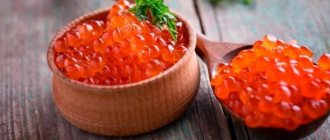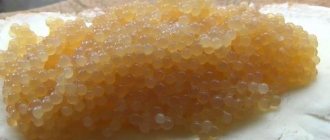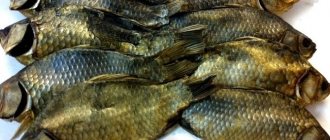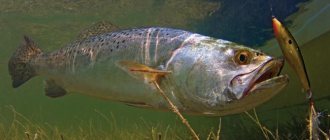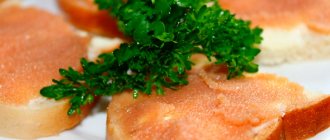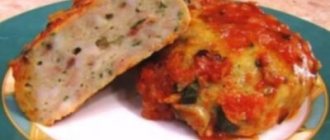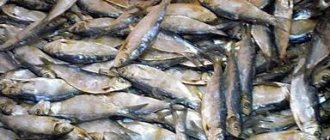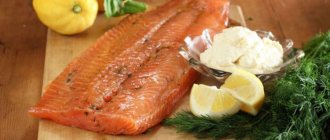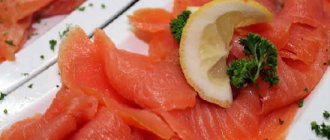A little about fish - sterlet
Sterlet is a freshwater commercial fish of the sturgeon family. The average length is approximately 60 cm, weight is about 2 kg. The color of the belly is yellowish-white, the back is dark brown or gray-brown. Life expectancy is up to 30 years. Under natural conditions, it prefers cold, clean water.
The size of the eggs rarely exceeds 2 mm, and their weight is 9 mg. Color: gray with a tint. The number of eggs depends on the habitat and size of the fish, varies from 5 thousand to 140 thousand. Natural spawning of females occurs at 6-7 years of life, artificial breeding reduces the age of females capable of spawning to 2 years.
When a fine is good
Russian legislation prohibits fishing for sturgeon in their natural habitat. To avoid a fine, the caught fish must be released. The ban stimulated the creation of new fish farms, the number of which is gradually growing. Sterlet breeding is of particular interest.
The lower yield of eggs is compensated by the faster sexual maturation of female sterlet compared to beluga or sturgeon. The return on serious investments is faster. Dimensions and weight allow optimal milking (collection of fish eggs) from sterlet. The extracted caviar is immediately processed and packaged in jars.
Types of caviar salting
- Grainy
Granular caviar is made from the highest quality, ripened eggs. By gently grinding, the eggs are freed from the roost (the natural film covering the eggs). Thorough rinsing with cold water allows you to get rid of substandard eggs and remnants of the roost. Caviar dried in a colander is salted at the rate of no more than 3% salt per unit mass and cooled. The liquid released during the salting process is removed. The caviar is placed in a heap, leaving no room for air. An increase in shelf life is achieved by adding boron and other preservatives. The product is ready for sale.
- Pasteurized
Jars with the delicacy are heated to 60º C, kept for 90 minutes, then cooled. The procedure is carried out 3 times. Pasteurization increases the shelf life of the product without preservatives from 2.5 to 8 months. Pasteurized caviar does not lose its beneficial and nutritional properties. The disadvantage of pasteurization is the denser shell and the less subtle taste of the delicacy.
- Yastychnaya
The yastik or poaching method of preparation is used by “lovers” of illegal fishing to quickly prepare caviar on the go. The fish removed from live fish is cut into strips and placed in brine heated to 40 ºC. The resulting product is much saltier and rougher in taste. It can be stored for less than a month due to its high fat content, which promotes accelerated oxidation of the product. Low demand for the product makes sales difficult.
- Payusnaya
Pressed caviar allows you to use the remaining substandard and deformed grains. Salting occurs in hot brine at 38 ºC, with two minutes of stirring, followed by drying and slight pressing. The product is considered ready if the formed handful is moderately sticky, reminiscent of rice porridge. Recommended shelf life is 4-8 months. The appearance of the delicacy is not as presentable as that of grain, but its pleasant, delicate taste dispels the negative impression.
Proper nutrition - good health
The wonderful, subtle aftertaste of black sterlet caviar is not its only advantage. There is a wide range of minerals, vitamin E and B vitamins, polyunsaturated acids Omega-3 and Omega-6. The balanced chemical composition of the gourmet product is an excellent prophylactic for:
- prevention of certain types of cancer
- anemia prevention
- eliminating the threat of cardiovascular diseases
- improved vision
- improvement of brain activity
Recipes for salting pike caviar
Simple technology based on sunflower oil
Product composition:
- pike caviar – 0.5 kg;
- salt – 3 tbsp. spoons;
- vegetable oil – 100 ml.
Salt is poured into cleaned and well-washed caviar. Take a fork and beat the contents until white foam appears. After this, 2/3 of the prepared vegetable oil is poured into the salted caviar and mixed thoroughly, after which the caviar is placed in the refrigerator. While the caviar is in the refrigerator, it's time to prepare jars for storing the caviar.
Since there is not a lot of caviar, it is better to take small containers, for example, for baby food, mustard or horseradish. Before use, the container must be sterilized with steam or in the oven for 15 minutes. The same procedure should be done with lids.
The caviar is poured into jars, and a 1 cm thick layer of sunflower oil is poured on top of it. The jars are tightly closed, and the caviar is placed in the refrigerator for 5 days. After this period, the caviar can be eaten.
Method of “hot” preparation of caviar
The following components will be needed:
- pike caviar;
- sea salt (for 0.5 kg of caviar you will need 2 tablespoons);
- sunflower oil.
This option involves cooking caviar in boiling salt water. If you add 400 g of salt to 1 liter of water, you will get a fairly salty solution called brine. After boiling such a solution for 2 minutes, caviar is poured into it. Literally immediately the caviar is removed from the heat and filtered. Before serving caviar, sunflower oil is added to it for taste. Such a delicacy can be stored in the refrigerator for no more than 3 days, although it is unlikely that it will be able to stand in the refrigerator for that long: it will simply be eaten.
Five-minute recipe
Cooking process:
- Take 1 liter of water for every 200g of pike caviar.
- Water is placed on the fire along with sea salt (fine). You need to take 2 tbsp of salt. spoons for every liter of water.
- Water with salt is brought to a boil, various seasonings are added to this composition.
- Prepared caviar is taken and poured with this marinade, after which the product is left for 10-15 minutes. In this case, only part (half) of the solution is used in order to disinfect the caviar and better clean it.
- After this, the water is drained and the caviar is filtered through cheesecloth. The remainder of the solution is put on the fire and brought to a boil, after which the caviar is poured over it again, but for half an hour. You can stir with a fork. After this time, the caviar is filtered again.
- The product is salted to taste.
- For 100g of caviar you should take 100 ml of sunflower oil.
- Beat the mixture of caviar, salt and butter with a fork until white foam appears.
- The caviar is placed in a transparent container and placed in the refrigerator for 4 hours. That's all, the homemade delicacy is ready.
Moderation as an indicator of good upbringing
Nutritionists advise rich and delicate lovers of black sterlet caviar to eat but not exceed the monthly norm of 200 grams. Neglecting advice can result in exacerbations of the following diseases:
- Cardiac ischemia
- Urolithiasis disease
- Hypertensive disease
- Gout
Choosing the right delicacy
The advantage of the Internet is to facilitate the purchase of any product, including sterlet caviar. The following steps must precede the purchase of the treasured jar:
- Preliminary selection of delicacy according to the type of salting (pressed or grain).
- Check the assortment and prices (the difference can be significant) of nearby stores.
- View reviews of the selected product on the Internet (preferably on several sites), survey friends and family.
After purchasing a delicacy, you must keep the receipt to file claims against the store if any arise. Purchasing through an online store makes it difficult to resolve a problem product and get a refund. When purchasing the selected delicacy, you can determine the quality in the store by shaking the jar. A sign of poor quality filling may be extraneous sounds inside the can.
russia-caviar.ru
Pressed caviar: what is it and how to prepare it?
In many books about pre-revolutionary Russia, when describing the feasts of aristocrats, such a dish as pressed caviar appears. What it is? Today we will not only learn about it, but also learn how to cook it.
In fact, pressed caviar is just one way to prepare sterlet caviar. For this we need:
- caviar - 100 grams,
- coarse salt - 10 grams.
- Number of servings: 4 pieces;
- Preparation time: several days.
We extract caviar in bags from the belly of the fish. Rinse and leave to dry slightly. At this time, line the bottom of a colander or sieve with a layer of gauze. Sprinkle a thin layer of salt on it. Roll the caviar bags in the remaining salt and place them on cheesecloth. Let it salt for several hours. We place a container under the colander so that the brine that is released during salting flows freely into it. While the caviar is being salted, you can relax, invite your friends to taste the delicacy, and photo albums on the website “Fishing for Everyone!” view.
We remove the caviar, place it on a dry cloth in a ventilated place and leave it to dry at a low temperature for a day or two. Then we remove the films from it, and crush the caviar itself a little with an ordinary potato masher so as not to crush the eggs. If the result is a rather dry mass, the brine left over from salting the caviar will come to the rescue. Warm it up a little and add it little by little to the caviar. The result should be a not too liquid mass. We put it on cheesecloth, form a sausage and wrap it tightly. We leave it under slight pressure for a couple of hours, and then free it from the gauze and cut it into washers.
ribalka-vsem.ru
Black caviar was traditionally obtained from three main species of sturgeon: beluga, sturgeon and stellate sturgeon.
It is curious that in reality, real black caviar is not completely black in color, rather the opposite: the lighter the caviar, the more valuable it is. Sturgeon caviar differs in chemical composition and in a number of other properties: the size and color of the eggs, the strength or elasticity of their shells, and, of course, taste.
Each type of caviar has its place in the “caviar hierarchy”, and therefore its price. This is explained, first of all, by the rarity or, conversely, the large number of a particular individual. However, under the conditions of artificial reproduction of sturgeon, the rarity factor is leveled out by human activity, so some producers do not comply with the price gradation at which, for example, stellate sturgeon caviar should cost less. In our opinion, this is quite fair, because each type of caviar has its own merits and its own connoisseur.
The first place belongs to beluga caviar. This fish is the largest of the sturgeons and the most valuable. Previously, it was famous for its size - it could reach 6 meters in length and weigh over 600 kilograms - but, unfortunately, in modern conditions in the wild this fish is not able to grow to such a size. More than 25% of the beluga's weight comes from caviar. Female belugas reach sexual maturity at about twenty-five years of age and may not spawn every year. The lifespan of a beluga can be more than 100 years.
Due to the enormous size of the individuals, beluga caviar is usually larger than that of other sturgeons; it is valued above all for its large eggs (up to 3.5 mm) and thin shell. The color of caviar can vary from light gray to almost black. The lightest caviar is the most expensive, although the taste, which experts describe as “the subtle aroma of the sea,” should not depend on color.
Sturgeon takes second place. The sturgeon can grow up to 2 meters in length and weigh up to 200 kilograms, although usually adult fish weigh from 20 to 80 kilograms. Life expectancy is from 60 to 80 years. Sturgeon raised in the warm waters of fish hatcheries reach sexual maturity at the age of 8-10 years. Even young sturgeon eggs are large and mostly dark golden in color. Sturgeon caviar can be completely different in color: from dark gray to dark brown and gold. As the fish ages, the color of the caviar changes to light amber and it acquires an extremely subtle odor, described as “nuts and cream.”
The third place is given to sturgeon. This is the smallest of the commercial sturgeon fish. It rarely reaches a length of 1.5 meters and, as a rule, weighs no more than 25 kilograms. The female stellate sturgeon begins to lay eggs earlier than other fish of the sturgeon family, at the age of 7 to 10 years, and its caviar is considered to be most delicious at the age of 18 to 22 years. The weight of caviar is 10-12% of the weight of the fish. Sevruga caviar is gray-black, the eggs are small and neat. Connoisseurs appreciate it for its unique, incomparable taste.
Despite the fact that sterlet caviar is not included in the “royal hierarchy” at all, the caviar of this fish is worthy of recognition by lovers of black caviar. Its small dark gray eggs have a subtle characteristic taste.
Currently, when fishing for wild sturgeon is officially prohibited, black caviar produced by fish farming enterprises is presented on the market in the following types: Russian sturgeon, Siberian sturgeon, white sturgeon, sterlet, beluga, bester
(a hybrid of beluga and sterlet). According to the method of preparation, sturgeon caviar is divided into granular, pasteurized and pressed.
Granular caviar
obtained from caviar of optimal maturity, with strong, elastic grain, uniform in size and color. Traditionally, granular caviar was divided into grades: Higher, 1st and 2nd. Now on labels you can find alternative names like “premium” or “imperial”, which are assigned to caviar by the manufacturer. The division of caviar into varieties depends on grain size, uniformity of color, consistency, taste, smell, and salt content.
Pasteurized granular caviar
can be made from sturgeon caviar of the highest or 1st grade. In addition to salting, such caviar is subjected to heat treatment (heating to 60-65 ° C), which extends its shelf life. Depending on the presence of flavor and grain size, it can be divided into varieties. As in unpasteurized caviar, the table salt content is allowed from 3 to 5%.
Pressed caviar was traditionally made from fresh caviar, which is unsuitable for cooking as granular caviar.
To make it, they use the brine method of salting (in brine) at a temperature of 40°C, then it is lightly pressed, as a result of which the caviar turns into a homogeneous mass. When selecting raw materials for pressed caviar, it is allowed to mix caviar from different breeds of sturgeon fish. The presence of foreign taste or offensive odor is not allowed. In appearance, caviar should be uniform, dark in color, taste pleasant, lightly salted, typical of pressed caviar, with a slight bitterness.
In all methods of harvesting caviar, the content of table salt is allowed from 3 to 5%. It is also acceptable to use a preservative (usually LIV-1/LIV-2 or E285).
www.ikra.ru
Are you looking for where natural sterlet caviar is sold in Moscow? Contact Tsar-Ikra LLC and we will deliver you the best and freshest product. Great selection and competitive prices guaranteed.
Sterlet caviar is a valuable and rare product. Indeed, in most cases it is produced by private farms, since fishing in the wild has ceased almost everywhere. Considering the small volumes of products supplied by farms, the cost remains quite high. However, it is fully justified by its taste, which has no equal.
The benefits of sterlet caviar
This amazing product contains half of the vitamins and minerals, amino acids, healthy fats and proteins that the body needs. All of them are contained in such forms and quantities that are favorable for human absorption. In regions where there is iodine deficiency and problems with the thyroid gland, black sterlet caviar becomes a salvation. It contains the required daily intake of this important substance. Also, by eating it, you get a supply of iron, calcium, phosphorus, and zinc, which is known to be essential for men's health.
It is recommended that young children and pregnant women eat caviar for general strengthening of the body. If you have undergone a complex operation or a serious illness, recovery will be much faster and easier.
Nutritionists praise black caviar because the fats it contains are much healthier than those we get from meat. 100 grams of this product contains from 200 to 240 kcal. It is useful to use it in case of iron deficiency in the body.
Benefits and harms
Sturgeon caviar contains a large amount of amino acids, proteins, vitamins A, D, E, B, macro- and microelements, saturated fatty acids. Calorie content – 230 kcal per 100 g.
Beneficial features:
- improves brain function and memory;
- good for vision;
- slows down the aging of the body;
- reduces the risk of developing cancer;
- has a positive effect on the cardiovascular system and blood circulation;
- improves mood.
There are several negative aspects to eating black caviar:
- not recommended for children under three years of age;
- should not be used by a person with individual intolerance.
It is necessary to observe the measure even for healthy people who do not have allergic reactions.
Black caviar is a very popular and expensive product. It has a special taste and is a favorite delicacy for many. But only proper preparation at home will allow you to enjoy fresh and natural caviar. The finished salty product will decorate any buffet table as an addition to salads, sauces, sandwiches and pancakes. If you know how to salt black caviar correctly, you can get maximum benefits and taste.
Sterlet is a representative of sturgeon fish. Sturgeon breeds are considered the safest against harmful microorganisms and parasites that can be infected by eating river fish. With the exception of wounded animals, sterlet specimens are pure, so you can enjoy the natural taste of caviar. Sterlet caviar is considered the most delicious black caviar on the market.
The optimal time for removing and salting caviar is 45 minutes after killing the fish. If caviar is processed immediately, it is most delicious. When the salting process is delayed, the taste deteriorates somewhat. Therefore, fishermen take out the caviar, salt it and eat it right away, enjoying the natural taste.
Not only sterlet caviar is eaten fresh. Even freshly caught sterlet is cleaned, cut into pieces, added a little salt and eaten fresh after 10–15 minutes. Heads and tails are used for fish soup. Greens are placed in the cut belly and sent to the smokehouse. The result is a fish called “Finger-licking good”* (additional bonus at the end of the text!). The only thing that tastes better is sterlet stewed in cream. For some, the best delicacy is freshly frozen sterlet, cut into thin pieces.
Selecting and storing caviar correctly
Many people don’t even know what kind of caviar sterlet has and buy a fake. At best, it turns out to be pike caviar, at worst - artificial substitutes with flavoring additives and dyes.
Manufacturers use different types of packaging. It can be metal, glass, or plastic. The good thing about a glass jar is that you can see the contents through its transparent walls and make sure that it is of proper quality.
The composition can only contain caviar itself, salt and a food additive - a preservative, which allows you to preserve the product in a closed package for up to 10 months. Only vacuum packaging guarantees long-term storage without loss of taste.
Sterling caviar is a healthy and nutritious product, but to preserve its properties it is important to store it properly. Never cool caviar to a temperature below - 6C. It should be served on a caviar plate made of glass, porcelain, or ceramics. Metal adds flavor and it heats up quickly on wood. Some restaurants have large caviar bowls lined with crushed ice.
When purchasing, focus on the following parameters:
- The size of sterlet eggs is from 2 to 2.5 mm;
- Color black, gray-black;
- The shell is soft and sensitive.
Tsar-Ikra.rf
Sterlet caviar. Recipe
For salting, it is good to use fresh product, but fresh frozen is also suitable. If your caviar has been frozen, do not forget the main rule - it should only be defrosted naturally. This way you will preserve not only all the beneficial properties of the product, but the integrity of each egg.
Salting caviar is considered the most traditional way of preparing it. The recipe for salting sterlet caviar is simple and not picky. You only need regular salt and one hundred grams of caviar. Lightly salted caviar cooks quickly, and therefore should be consumed just as quickly. Place the caviar in a washed glass container, then add fine salt. In 10 minutes your delicacy is ready!
Another recipe for sterlet caviar that you will certainly appreciate is salting with added sugar. You need 50-80 grams of salt per liter of water. Sugar is required twice as much. Bring the water to a boil, add salt and sugar. And then cool the marinade. As soon as the marinade has cooled, pour it into the caviar, in a ratio of 2 to 1. That is, there should be twice as much water. The eggs should remain in such a pickled bath for a quarter of an hour. Then drain the water and place our delicacy in a glass container. The advantage of this recipe is that the delicacy has no shelf life limit.
Sterlet caviar can also be used in cooking.
Delicious recipe! How to properly cook eggplant with garlic
Surprise your guests with a multi-layer salad. To prepare you will need:
- 100 g boiled rice
- 500 g boiled squid
- 150 g hard cheese
- 2 boiled eggs
- 200 g boiled shrimp
- 2 cloves garlic
- 2 tomatoes
- Mayonnaise
- Black caviar
Lay the ingredients in layers, cover each layer with mayonnaise and chopped garlic sauce. Garnish your salad with caviar.
Black caviar, whether granular or pressed, is an excellent decoration for salads and side dishes. Sturgeon caviar is also served as a cold first-class appetizer. Slightly chilled caviar is especially tasty. It is placed in a special dish - a caviar bowl, which is made of glass, porcelain or ceramics. And finely crushed ice is placed into the metal part of the caviar maker.
Sterlet is a representative of sturgeon fish. Sturgeon breeds are considered the safest against harmful microorganisms and parasites that can be infected by eating river fish. With the exception of wounded animals, sterlet specimens are pure, so you can enjoy the natural taste of caviar. Sterlet caviar is considered the most delicious black caviar on the market.
The optimal time for removing and salting caviar is 45 minutes after killing the fish. If caviar is processed immediately, it is most delicious. When the salting process is delayed, the taste deteriorates somewhat. Therefore, fishermen take out the caviar, salt it and eat it right away, enjoying the natural taste.
Not only sterlet caviar is eaten fresh. Even freshly caught sterlet is cleaned, cut into pieces, added a little salt and eaten fresh after 10–15 minutes. Heads and tails are used for fish soup. Greens are placed in the cut belly and sent to the smokehouse. The result is a fish called “Finger-licking good”* (additional bonus at the end of the text!). The only thing that tastes better is sterlet stewed in cream. For some, the best delicacy is freshly frozen sterlet, cut into thin pieces.
Stages of preparation for salting
In order for black caviar to be clean, beautiful and tasty, it is important to know how to properly prepare it for salting.
Preparation stages:
- The joints should be removed carefully without damaging the integrity;
- Sterlet, beluga or other sturgeon caviar must be cleared of film. This process is easier to accomplish using a fork, wooden spoon or sieve;
- It is recommended to rinse it well;
- It is better to use fresh product for salting, but freshly frozen is also suitable. Defrosting is carried out naturally, first on the bottom shelf of the refrigerator, then on the table;
- you will need at least 150 grams. egg masses;
- You can salt it with simple fine salt;
- Use only non-oxidizing containers.
Salting caviar at home is not difficult. By following all the recommendations, her own taste will only become brighter and richer.
Salting recipes
Salting red caviar at home is a simple process, the main thing is to thoroughly clean the product.
- Pour the cooled brine over the raw materials for salting (hot ones can ruin the delicacy) and leave for 20 minutes.
- A 20-minute soak is enough for storage for a couple of days (and it’s not possible longer), if you immediately serve the product on the table, 7-10 minutes will be enough.
- place on cheesecloth and let dry for a couple of hours, transfer to jars that have been previously sterilized and oiled on the inside.
What to do if red caviar is very salty? There are ways to help the cause. First - pour warm water for 5 minutes, stir gently and drain in a colander. Second - rinse with tea leaves, as in the first case; by the way, this method will help with unpleasant odor and rottenness (although in this case it is better not to use the product at all).
Cooking in brine
For brine, you need to boil water and cool it slightly to avoid hardening of the eggs. Salt the liquid little by little, determining the amount by the floating potato.
Advice! The liquid should be twice the volume of black caviar.
The finished mass is poured with brine. Exposure will depend on the storage period provided. 10 minutes is enough if you want to enjoy the dish right away. It will take about 30 minutes to stand for a long time, and the taste will become much saltier. The next step is to drain the marinade and dry the eggs a little in a colander. Place the mixture in a container and mix with olive oil. Place in glass jars, having previously sterilized them. Send to a cool place for storage.
How to salt sterlet caviar in brine
The brine is prepared so strong that a raw egg, onion or potato floats in it. Use fine salt of good quality: for 100 g of caviar 125 g of salt (or a little more). The volume of brine should be three times greater than that of caviar.
Delicious recipe! House plants according to zodiac signs
Add salt slowly into boiling water in small portions and stir. Boil until the salt begins to crystallize (a white coating in the form of a crust of salt crystals appears on top of the water). Far Eastern fishermen advise boiling any brine (even repeatedly used, which is stored throughout the poutine) for at least 15 minutes.
Next - no contact with fresh water. The eggs are poured into a cold or warm solution (temperature 40–60°) or poured into brine - there is no difference.
Salting sterlet caviar in time depends on its expected shelf life. If caviar is salted for instant consumption, stir until the caviar, absorbing the salt, begins to knock on the walls of the dish. Usually kept in brine for about five minutes. For long-term preservation, the holding time is increased to 20 minutes.
It’s even better to pour the caviar for preservation twice with brine, dividing it into 2 parts. Keep in brine for 7.5 minutes each time. (If you pour five-minute caviar twice, then keep it for 2.5 minutes). Double pouring will better clean the caviar from residual blood and impurities.
Then the water is allowed to drain well, hanging the eggs in a gauze bag. This process takes several hours. Better than a day. During this time, the caviar ripens.
The process of salting sterlet caviar in brine is completed. The result is a delicate, crumbly, grainy delicacy with a pleasant black color.
If there is an excess amount of caviar, it is laid out in jars, which are first doused with boiling brine. All utensils used for salting sterlet caviar are treated in the same way. Pour a couple of tablespoons of vegetable oil on the bottom and the same amount on top. Store for a couple of months.
A large amount of caviar is eaten with spoons: either pure caviar or mixed with onion, fresh dill and vegetable oil. Caviar is delicious with hot boiled potatoes. A small amount is served on halves of boiled eggs, on pieces of bread, pre-greased with butter.
The answer to the question of how to salt sterlet caviar at home is given.
Now the promised bonus:

